13 Sentinels: Aegis Rim (PS4) Review – Fragments of Time
Playing 13 Sentinels: Aegis Rim is like playing through every mecha and kaiju movie you ever watched in the 80s and 90s, with everything that makes them great, and a few things that hold them back. The first few moments of the game depict the Kaiju invasion of downtown Ashitaba City (just think Tokyo) and a few high schoolers suddenly whisked away and thrust into the cockpits of a team of mechs, the Sentinels, and tasked with defending the city.
That premise will make you think of an RPG style setup, but that’s not really how 13 Sentinels rolls. There’s no open world, no field map, no dungeons, and certainly no item management, thank the Kaiju. Instead 13 Sentinels is a more traditional Japanese-style game built out of a selection of different screens and menu-types. It put me in mind of Front Mission, not just for the mechs, but for the mech customisation screen, the battle screen, the still backdrop narrative sections with still frame character art.
Games have clearly moved on and 13 Sentinels takes that really rather old school Japanese style and upgrades it to current gen. The narrative is presented on lush painted backgrounds and works something like a visual novel, and the battles are not turn-based, but instead feature everything you’ve ever wanted a fast moving strategic mech battle to have.
But let’s try to break it down, because 13 Sentinels is very high concept, and very complex. From that first battle, you will tackle the prologue, get introduced to most of the 13 lead characters across 6 of their prologues, and get a basic tutorial on all the aspects of the battle system over 7 staged fights.
At this point I thought this would be the structure going forward, alternating between fighting and narrative, but once the prologue ends, the game suddenly opens up into three disparate sections that don’t really meet. We’ll tackle each one in some depth, because that will help you understand this unique game; Remembrance is the story mode, playing through an individual story for each of the 13 lead characters; Destruction is a self-contained battle mode, with its own timeframe, separate from the timeframe of the story mode; and Analysis is an in-depth lore and mystery files section, where you look through everything you’ve revealed and try to make sense of the narrative.
These different modes sound rigid, but in fact you have just been given a hell of a lot of freedom. Wanna do a bunch of battles and leave the storyline for a bit? Fine. Wanna advance the story and not bother with fighting for ages? You can do that too. It seems the best overall way of doing everything is by alternating between the two, but that is A, not chronological, and B, counter to the freedom on offer.
Let’s take each of the game modes in turn, and see if I can’t explain why 13 Sentinels is incredible, the freedom and structure is something you’ve never seen before, and how I was so influenced by it I ate noodles in a sandwich.
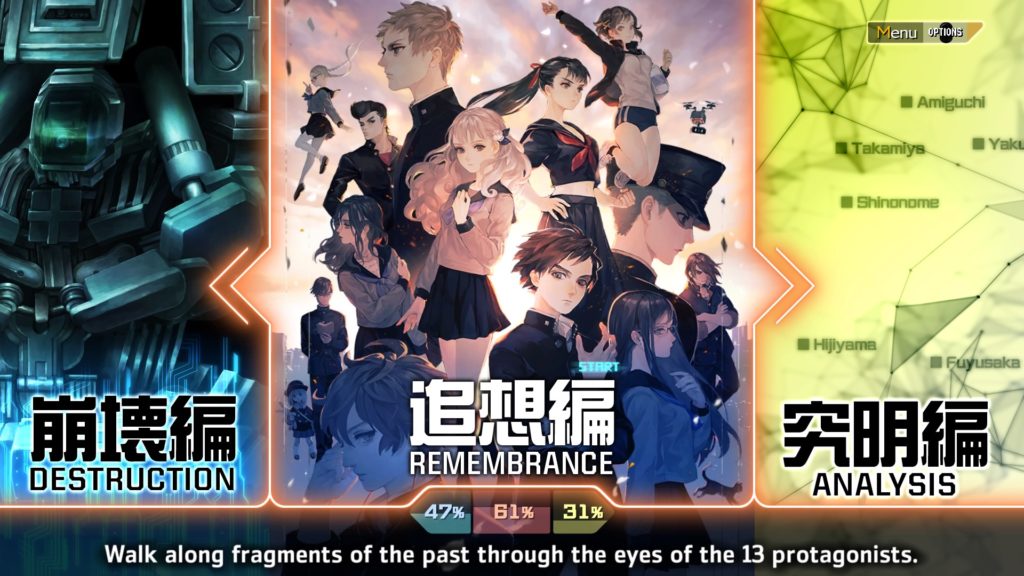
Reviewing the story of 13 Sentinels is a daunting prospect. It’s like watching a bunch of Christopher Nolan’s movies at once; Inception (for its dreams and implanted ideas), Memento (for ununreliable memories), and Interstellar (for its science fiction and time travel), and all the complexity that would bring. It takes itself completely seriously, and to be honest, it’s going to lose a few people. I can’t honestly say I fully grasped it myself. Even the prologue will seem like too much to some, and then the actual game will open up, and blow your mind.
Remembrance is 13 characters and 13 stories, that you can tackle in any order you want. Each one is split into between 7-9 chapters and you can stop and start them anywhere along their path. You could do one chapter of each character and then go round again, or you could concentrate on one character for a while until you reach one of the few gated scenes. It’s possibly the most extensive control over your discovery of a storyline I think I’ve ever seen. There are multiple flow charts and entire glossaries to manage the chapters and your routes through them. No one will experience this story in exactly the same order as anyone else.
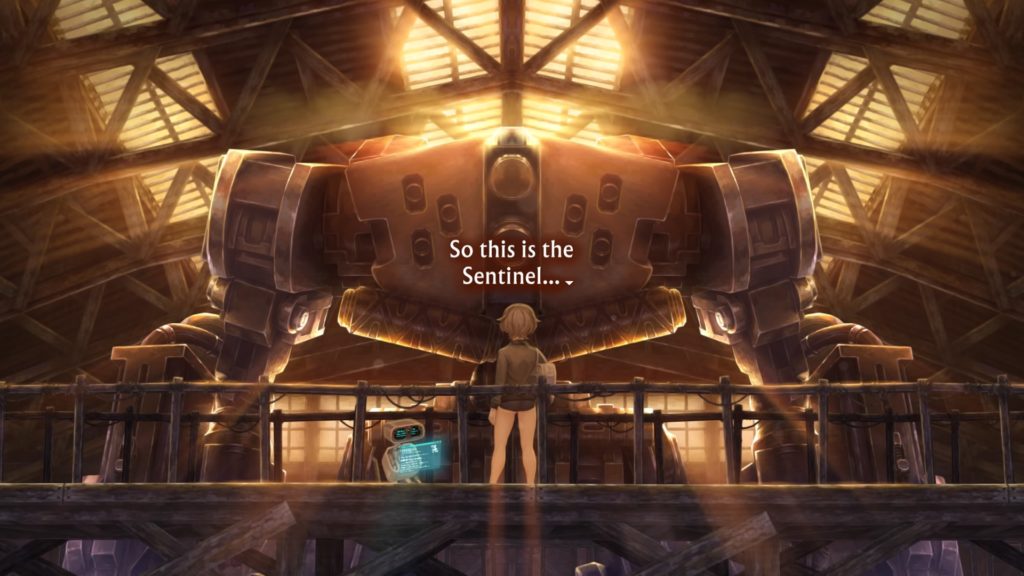
So what’s the story? Okay, I will not be able to explain the story in any way that does it justice. It’s the type of narrative experiment that needs video essays and articles to be made about it for years to come.
It’s 1985. 13 students, 13 lead characters, come together from multiple timelines and walks of life, to fight the threat of kaiju invading their city. There’s Juro Kurabe, a young Kaiji movie buff, whose favourite movies seem to be coming true; there’s Megumi Yakushiji, a shy student who is goaded into a number of shootings by a talking cat; there’s Yuki Takamiya, a surly female gang leader from another school, who finds herself being used as a spy for the government; there’s Natsuno, a sci-fi fangirl on the track team, who finds a small robot and befriends it only to be whisked off to the 1940s; there’s Takatoshi, a soldier from the 1940s, whose crush is a girl who seems very involved in creating the Sentinels, only for him to find out she is actually a boy who knows entirely too much about time travel; there’s Ei, who has amnesia and wakes up next to a body; and there’s Nenji, a young punk, whose living the same half hour before the attack over and over, trying to find a way out. And that’s just half of them.
13 narratives can seem a little much, and it is to start with. It worried me going in, that it would be hard to really care about them all. But by treating them all as the main character in their own story, 13 Sentinels manages just that. No one character gets left behind. Every character is involved in every other character’s story, at least in some way. It’s a feat of narrative design that any of it is coherent, considering you can tackle it all in almost any order you wish. With such a lovable and strong cast, one of the hardest things to do is decide whose story you want to explore next. It really is confusing to start with, but then with time, answers start to flow, identities start to coalesce, and you will begin to understand where everyone comes from, and how they fit into the puzzle.
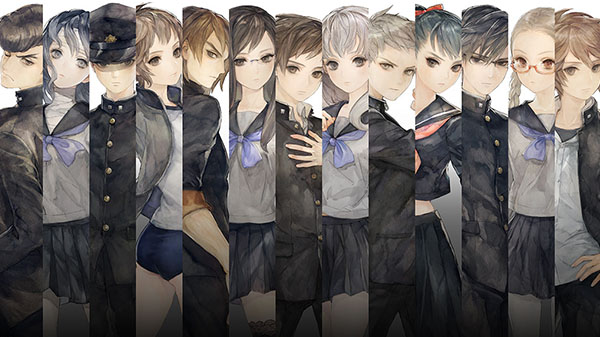
There are a lot of amnesiacs, flashbacks, doppelgangers, dreams, and multiple versions of people from different timelines – while all of it is interesting, I often wondered if everything would actually make sense in the end. Amnesiacs and flashbacks are pretty tired devices, and I found the flashback and memory loss was really only an impediment to understanding the story. These things could have been tackled in a more chronological order, but the Analysis section goes someway to organising things.
One of the fun quirks that sets Japanese modern anime aside from western animation, is the common trope of having protagonists have internal monologues and vocalise to the audience everything that going on in their heads. Where western storytelling tries to show not tell, anime tells all of the things, all of the time. And in 13 Sentinels, there is an entire game mechanic built around it. For every key word, character name, or plot point uttered during conversations, you can access the internal thoughts of your current character via a simple button press. Its constantly integral to scene progression, and though it may be jarring and seem somewhat time consuming to western audiences, it’s a wonderfully integrated system, that will make you feel more like you are watching an anime than I think many games have ever achieved.
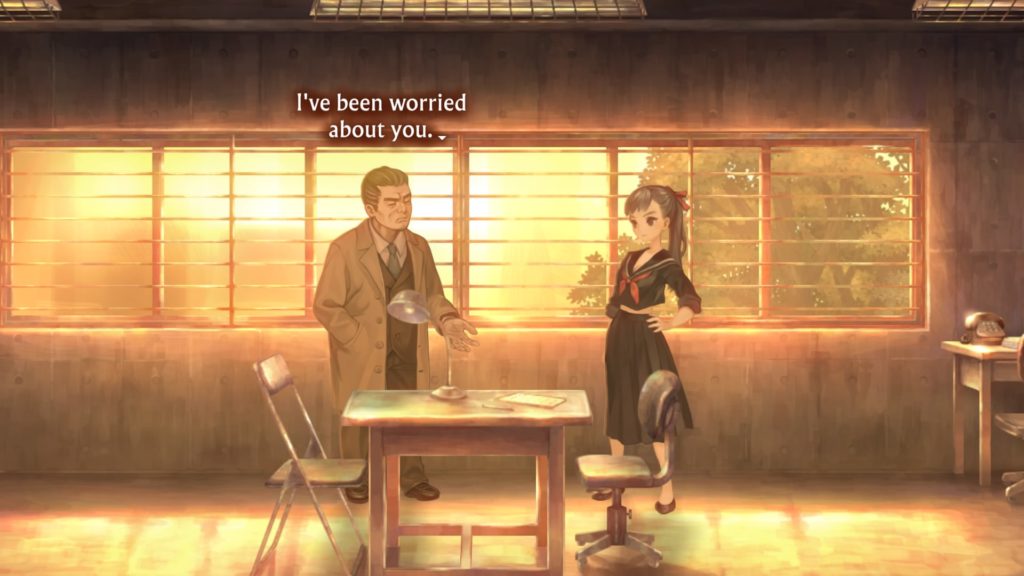
I played the game in true anime purist-style; all subs, no dubs. With subtitles you are going to need to pay attention, because there is a lot of text, and in battle there are commands and info coming up in more than one place at a time. Text can be skipped and at the push of the touchpad there is a text log, which I am seeing more and more of in these long and complex JRPGs.
With the incredible decision to give this level of freedom to narrative progression, comes the downside. The story can suffer a bit from this structure – there is no three-act structure and little in the way of satisfying story arcs. Characters will come to realise something important, or that they love another character enough to fight for them, but the stories are basically fragments, unwilling and unable to really tell the whole story on their own. I’m not saying it doesn’t make sense, because I think it does, but you need to be prepared to fill in the blanks yourself. In a story that spans multiple time periods, time travel, and characters with different identities, this can be a tough ask. On a positive note, the game constantly delivers mind-blowing reveals as you find the mystery getting bigger and bigger.
Lastly for story mode – do you love flow charts? Well I hope your answer to that question was yes, because every one of the 13 characters, every storyline, every chapter breakdown, is represented on a scene by scene, decision by decision flow chart. I mention this to just to give you an idea how complex this narrative structure is. I don’t think you have any chance of fully grasping everything in the story first time round. There’s just simply too much going on. If you like a good story, and are prepared to be confused for most of the 35-hour run, right to the final scenes, this is a story mode like no other.
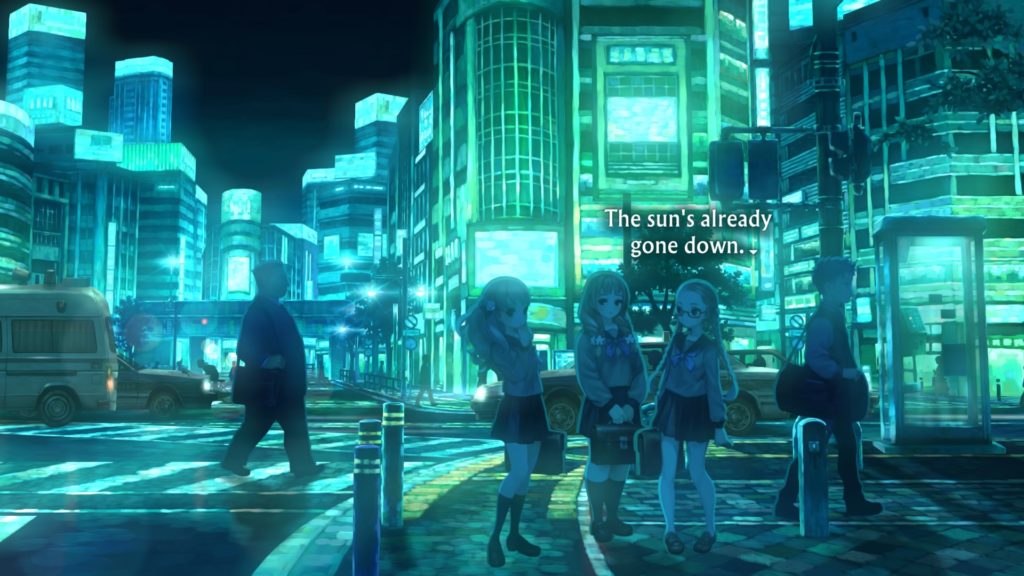
Characters are the draw through a story this complex, and 13 Sentinels’ cast shines through to draw you on and on. I never tired of any of them, and each has quirks that make them interesting or likeable. Each and every one is handled like the main character of a lesser game. Lovable Natsuno’s relationship with a little R2D2-like robot, and punk Nenji’s Groundhog Day search for a way out of his never-ending time loop are both standout stories.
Another very interesting story involves a male character who dresses as a girl, only for Takatoshi Hijiyama, a young soldier, to fall for them, first as a girl, and then after some confusion when their true identity is revealed, as a man as well. Its a tale of acceptance, and while not quite a transgender relationship, it certainly becomes a homosexual relationship, with drag overtones. It’s nice to see something queer-positive and representation-positive in an Atlus property, where a lot of the time, LGBTQ+ characters are treated as stereotyped comedy relief. I’m glad to report this story is handled with care.
Takatoshi is also obsessed with a particular food he found in a new time-period – Yakisoba Pan, which to westerners is Yakisoba noodles in sauce, in a sweet bread roll. He talks about it regularly and eats one on a number of occasions during his story, to the point that I had to try it out and recreated my own at home to try. Short answer, it was good. Carb heavy, but tasty.
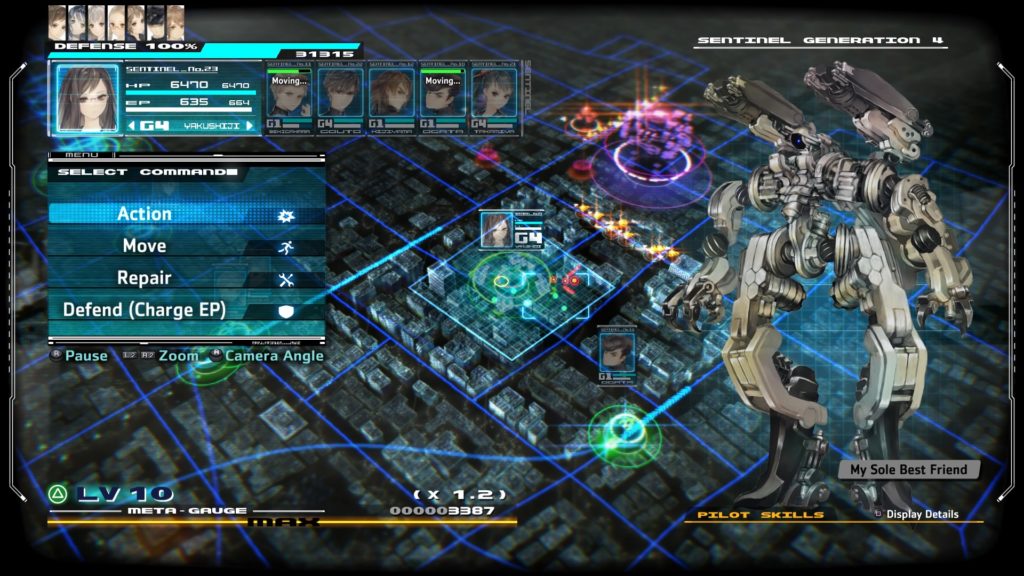
The mech battles in 13 Sentinels take place on a holographic isometric 3D map representing the city, but in blue outlined virtual graphics, making it look very Zone of the Enders. Think of yourself as the battle commander, in strategic control of up to 6 Sentinels, with the other 7 locked out in each fight. The actual mechs themselves don’t appear on the map and nor do the kaiju – instead virtual tactical representations appear, with the names of the pilots and sentinels, or the neon outline for the kaiju.
The battles are real-time and turn-based at the same time. Kaiju will fall from the sky, attack and head towards the Aegis, but the action pauses every time your sentinel’s turn comes around. It’s governed by an active-time bar, like a lot of turn-based RPGs. Action stops, and you can choose one of your many attacks, or to defend or move to a better flanking position or get in range.
Your job in most missions is to wipe out the Kaiju in a certain area, or destroy specific units, and to protect the Aegis, which is your base node, that is slowly charging. When fully charged it can wipe out the kaiju, but you can’t really control it, and it will only fire once the mission parameters have been achieved.
Your Sentinels come in four flavours, four different generations of mech creations, each with its own strengths and weaknesses and different tactical usages; The 1st gen are the hard hitters, ground based, melee machines with expensive single hit attacks that can down large Kaiju, they are best against ground based enemies; 2nd gen are allrounders equipped with long range missiles and can set up sentry guns, and are best kept out of the fray; 3rd gen, are long range but equipped with railguns and EMPs, giving them a tactical usage in downing the aerial enemies for the ground based melee of the 1st gens; and 4th gen are the newest fastest models, capable of flying over the city, shooting area-impact missiles, but they have quite low health. You can see within that scope, it’s good to have a spread of each type, and that they support each other. Kaiju clumped together, send in a 4th gen, while a 2nd gen sets up a sentry gun to pick off stragglers, for example.
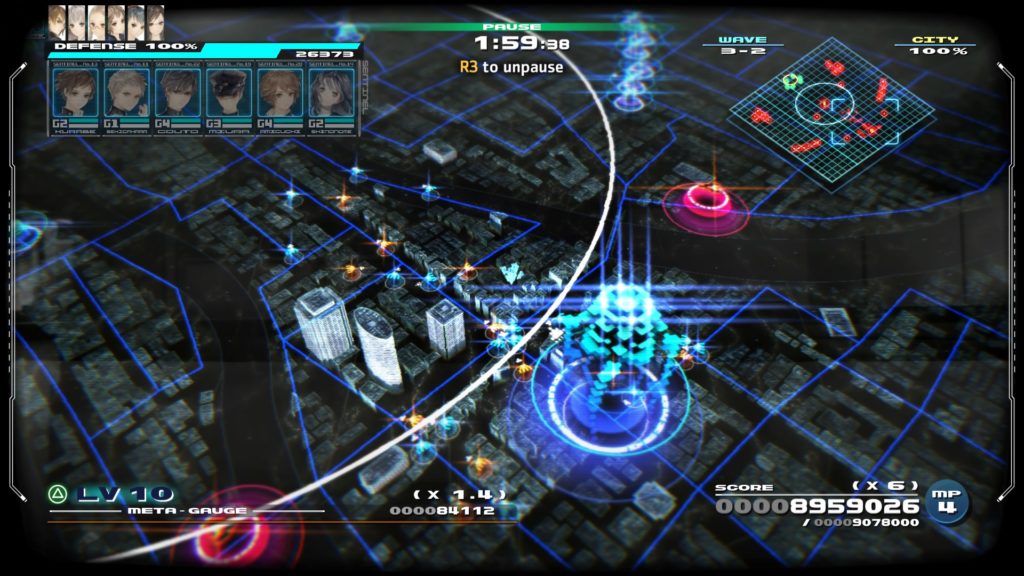
There are lots of weapon types, and all have different uses – some are wide area circular impacts, some conical spreads, some surround the sentinels, and some are straight beams for when the kaiju line up on roads. Your sentinels are also confined to moving along the roads, except for the more manoeuvrable 4th gens. The 2nd gen’s sentry guns are awesome – plug 4 sentry guns down and you can cover half the map, and rinse your way through at least the first ten battles.
Every attack has a cost in EP, which will replenish under certain circumstances or by defending for a turn. You can also get out of the action and repair your sentinel for a turn. For the first ten of so battles, you’ll hardly need it; they aren’t that hard on normal mode, and I got ten S ranks in a row, but it can get trickier into the 2nd and 3rd set of 10.
The speed and control you have on the field is really kind of fantastic. Vanillaware have included a deft spread of different weaponry allowing all sorts of different tactical advantages if you think carefully. It’s fast, satisfying and really makes you feel like the commander of a mech squad protecting your city, where I think turn-based mech battlers suffer from the unrealism of taking turns, and first person mech games lose the tactics. 13 Sentinels may have separated the battles from the story, but the battle mode is addictive and I am sure I will come back to that mode, to get S ranks on every mission.
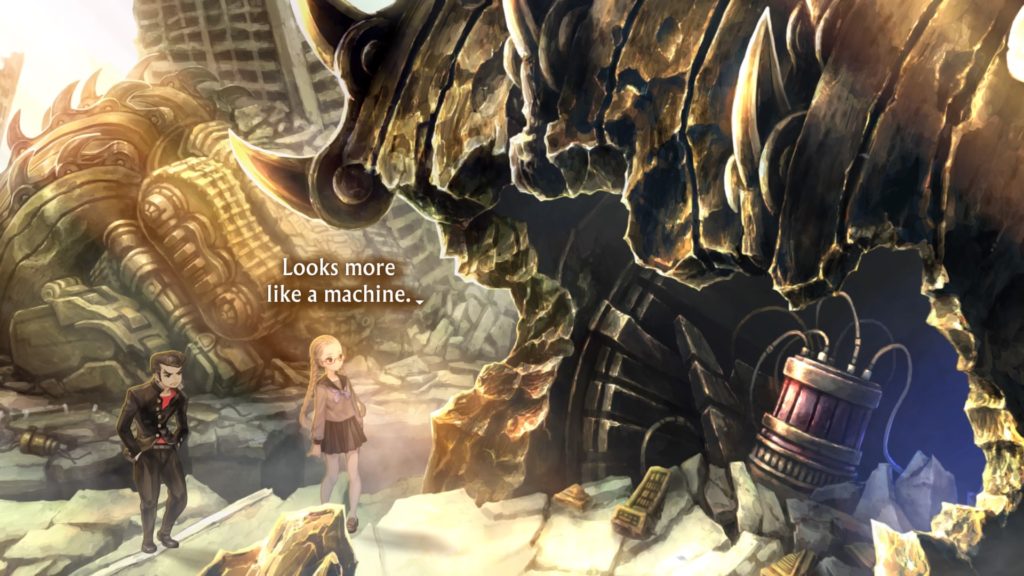
Levelling up is also handled differently than in most RPGs. You get experience in battle and level up your pilot, but this is secondary to the far more useful weapon system. Your score and speed in battle will equal meta-chips, which you use to buy and upgrade the actual weaponry of the mech, and these meta-chips are even more prevalent in the story side of the game. Work your way through the timelines, find the hidden events, and you earn meta-chips. The upshot, is that the game does away with grinding for levels almost completely. It’s just never necessary. You will get everything you need to succeed, just by following the story.
The third and final mode is the Analysis section. It’s effectively a massive glossary of every term and mystery you’ve come across in the story, and a way to rewatch every single scene. You earn mystery points in battle, which you can use to unlock mystery files, and uncover even more information. It’s been gamified, in that you need to complete the whole glossary, but I do think they missed a trick here. I thought initially that the files you uncovered then gave you topics in the thought clouds in the story mode, but after some experimentation I found this wasn’t the case. I think this would have tied this mode into the whole a little better than it is currently.
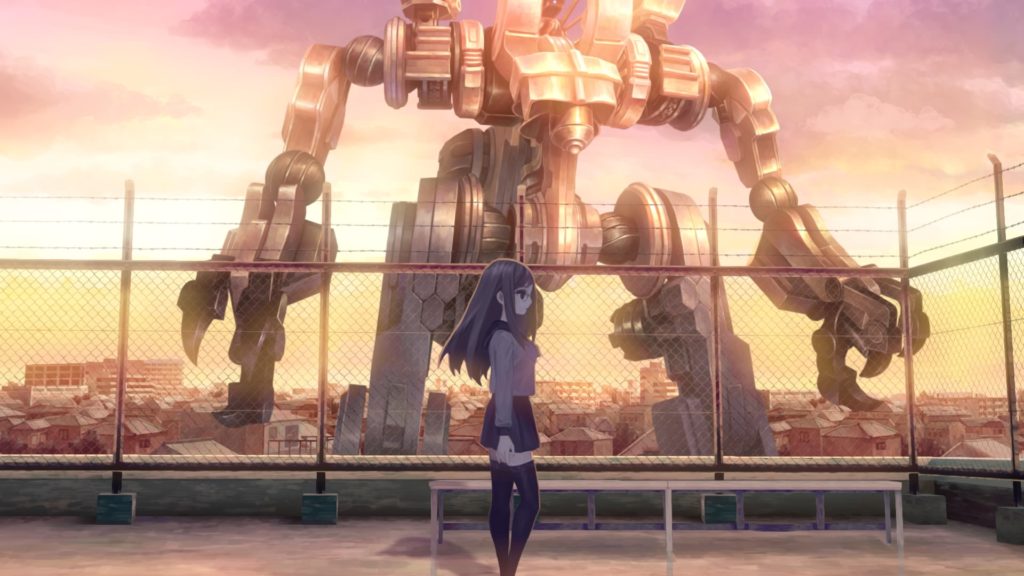
A review of a Vanillaware game would not be complete without discussing the studio’s famed art and graphics. Ever miss the great games from the PSX era with their pre-rendered backgrounds, that characters would be able to walk around and interact with? It’s not something you see very often these days. But those games looked incredible for their time because their worlds weren’t really subject to the same rules.
I realised suddenly as I was playing 13 Sentinels: Aegis Rim, that the thing I actually really liked about the artwork, was how close it was to pre-rendered backgrounds. These of course are more like pre-painted, and they aren’t static. They often move beautifully, with mechs walking about, or just the wind in leaves, but they give the game a sense of being something timeless, that could have come out on any console in the last twenty years. It’s like watching an anime painting, and that timeless quality is likely to mean the game will age very well. Character models are wonderfully animated and expressive, and you will very quickly start to enjoy the style of the whole package.
It’s also exceptionally well made. With next-gen floating over us, and it’s promise of no loading times, it was interesting to note the work on loading already possible on the PS4 – I never experienced a single loading screen in the story mode of 13 Sentinels, and only a few seconds in the battle mode.

The music in 13 Sentinels follows a really appropriate Ghost in the Shell type vibe, with glittery glitchy orchestral themes, Okinawan folk singing and a fun battle theme. I don’t think it’s one where I’m going to be downloading the soundtrack, but it’s really good nonetheless.
Playing in Japanese with subtitles means it is hard as a westerner to judge a Japanese voice cast, but I found the voice work expressive and varied. I am reliably informed that the entire game has an English dub available as a day one patch, but for this review I won’t be able to comment on the English cast performances. You can judge for yourself on the brand new english trailer below.
So, just as daunting as the storyline, is the prospect of trying to give 13 Sentinels a score.
13 Sentinels doesn’t conform to your preconceived notion of what an RPG should be, or how it should be structured, and takes the tried and tested formulas and throws them out. It splits battles and story into different modes, throws out the grind, the overworld, the dungeons, everything it doesn’t need to tell its serious story about androids, time travel, mechs, kaiju and anime, all rolled into one.
It’s story doesn’t conform either; it’s broken down into 13 individual stories, split into chapters and scenes, all of which you can approach in any order you like. It’s a fascinating story, made all the more interesting by this incredible level of freedom, which reveals the story in a different order for every player. Every protagonist is nuanced, lovable, interesting and all are handled with care and heart.
And it has possibly the best tactical mech battle system I’ve ever played, rivalling the Front Mission series, Battletech and Into The Breach for having both turn-based and real-time elements. The system makes for something fast and frenetic yet truly tactical, and you feel like a real battle commander with the isometric holographic overmap. I just wanted more.
13 Sentinels is a game that knows exactly what it’s audience wants. It felt like it was targeted specifically at me. If you grew up loving sci-fi anime and mechs, Neon Genesis Evangelion, Metal Gear and Front Mission, then this is like playing the best version of them in decades. A real contender for RPG of the year.
13 Sentinels is the deepest of narrative experiments, with none of the form of a normal RPG, and a visceral and addictive strategic mech battler. It channels everything good about Japanese mech anime and games from the last 40 years into something beautiful, timeless and incredibly niche. A real contender for RPG of the year.
9/10
13 Sentinels: Aegis Rim is a PS4 exclusive and comes out on the 22nd September 2020.
Developer: Vanillaware
Publisher: Atlus
Disclaimer: In order to complete this review, we were provided with a promotional copy of the game. For our full review policy, please go here.
If you enjoyed this article or any more of our content, please consider our Patreon.
Make sure to follow Finger Guns on our social channels –Twitter, Facebook, Twitch, Spotify or Apple Podcasts – to keep up to date on our news, reviews and features.

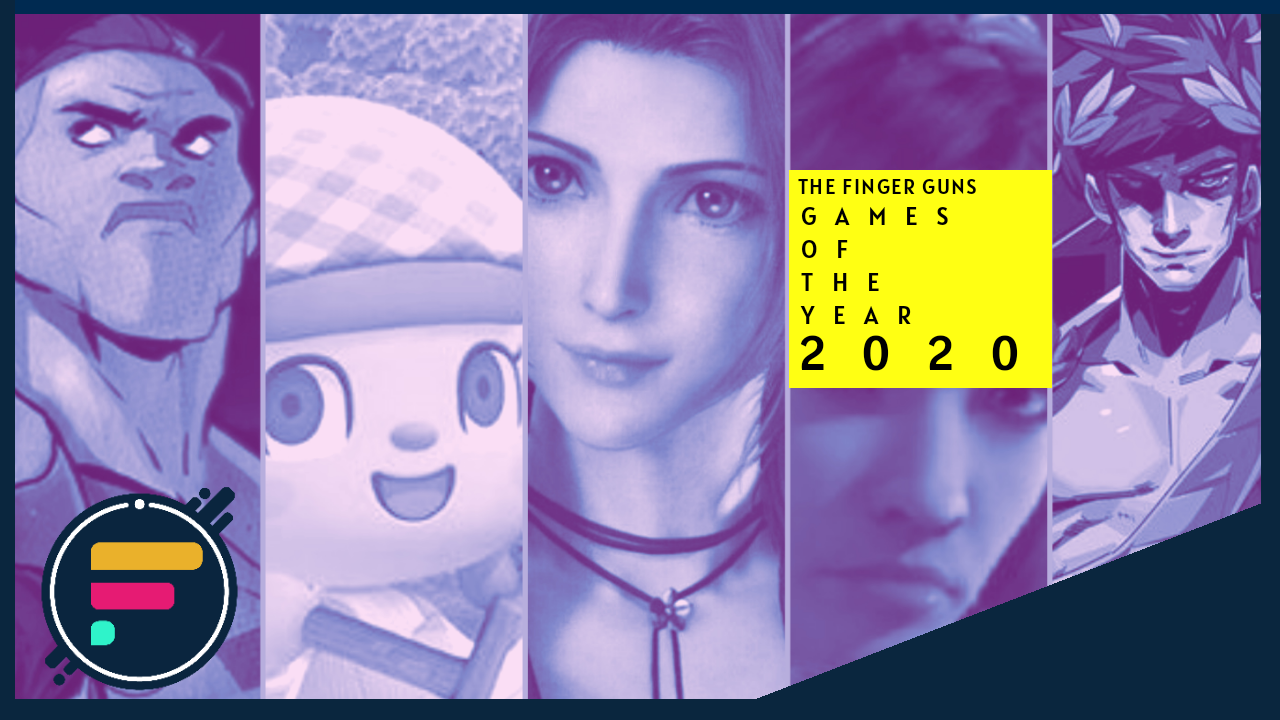
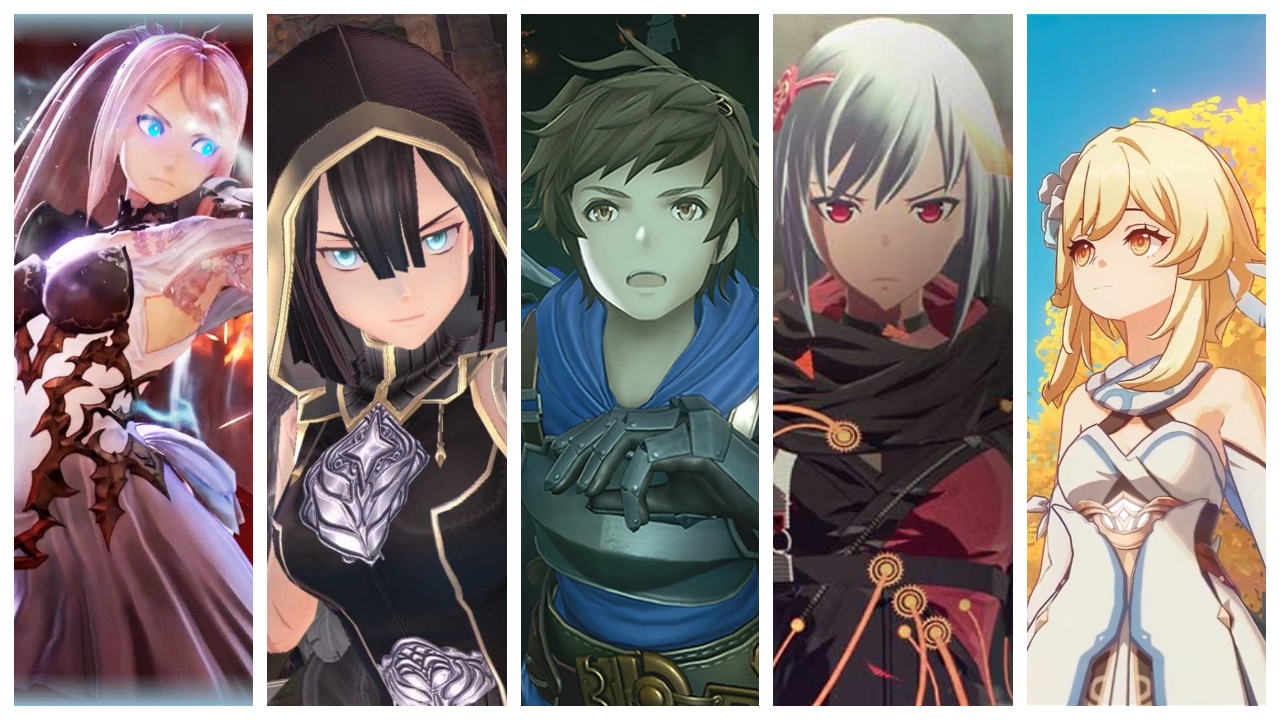
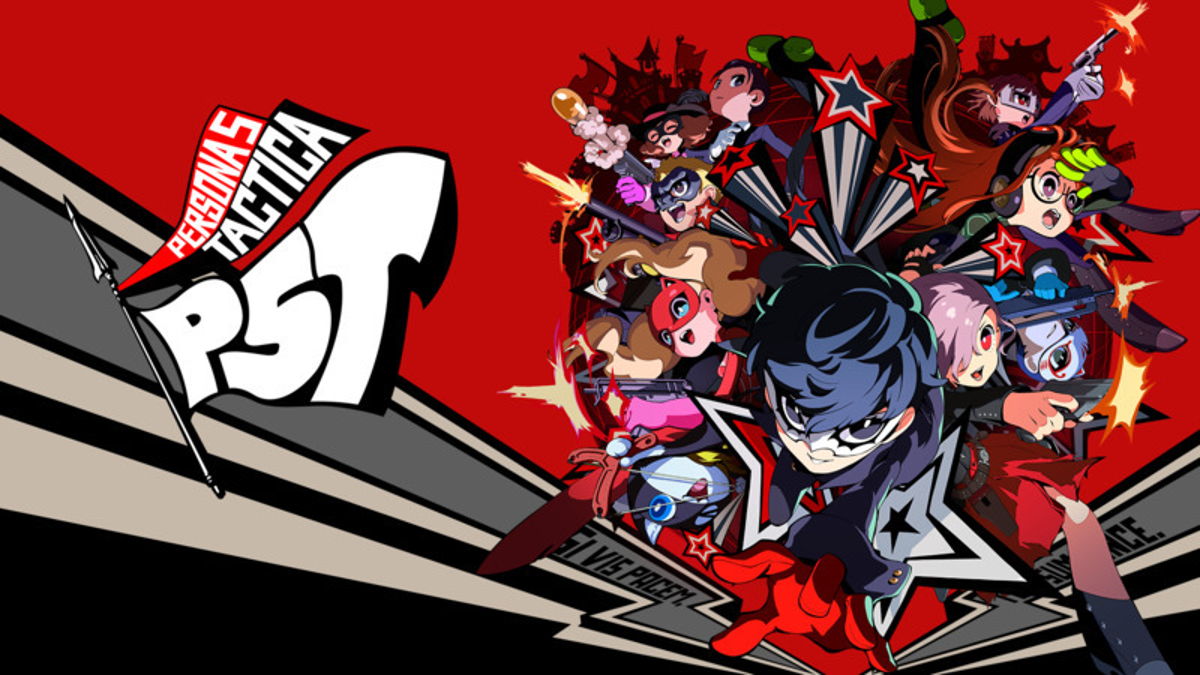
Pingback: 8 Massive JRPGs We Can't Wait To Play - Finger Guns
Pingback: Finger Guns Presents: The Games Of The Year 2020 - Finger Guns